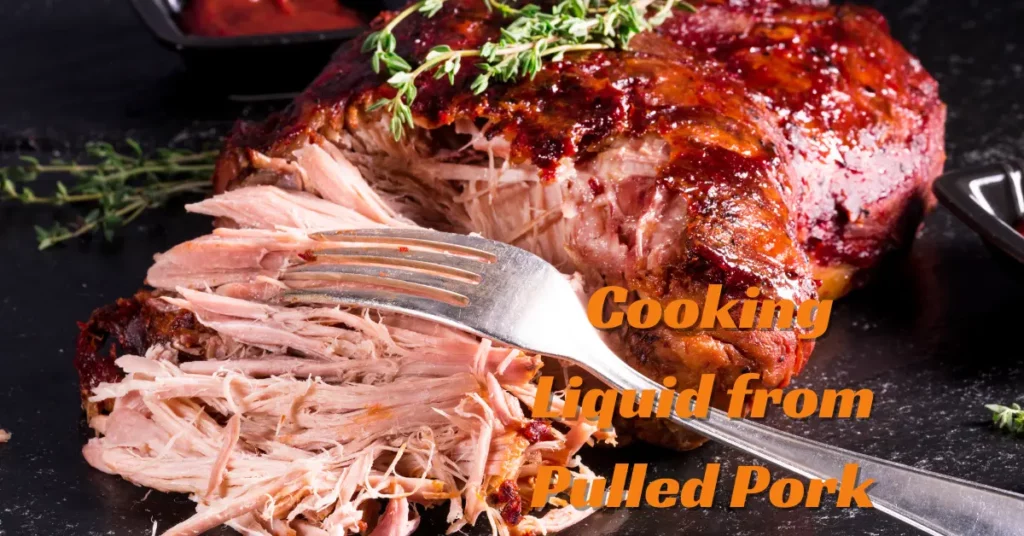This post may contain affiliate links. If you use these links to buy something we may earn a small commission. Thanks.
Pulled pork is a barbecue favorite known for its tender texture and rich, smoky flavor. Whether you prepare it in a slow cooker, smoker, oven, or pressure cooker, the cooking process generates a significant amount of liquid. This liquid is a mix of rendered fat, meat juices, and seasonings that have accumulated during the cooking process.
A common debate among pitmasters and home cooks is whether to keep or discard this cooking liquid. Some argue that retaining it enhances moisture and flavor, while others prefer a drier texture and opt to remove it. In this article, we’ll break down the pros and cons of keeping or discarding the cooking liquid and provide best practices for managing it to ensure the best-tasting pulled pork.
Understanding the Cooking Liquid
Before deciding whether to keep or remove the cooking liquid, it’s essential to understand what it consists of and how it affects the final dish.
What Is in the Cooking Liquid?
- Meat Juices: As the pork cooks, its natural juices are released, contributing to the rich umami flavor.
- Rendered Fat: Fat from the pork melts during cooking, creating a layer of grease in the liquid.
- Seasonings & Marinade: Any rubs, brines, or injected marinades used before cooking will also mix into the liquid.
- Collagen & Gelatin: Slow-cooked meats release collagen, which thickens the liquid and contributes to a silky texture when cooled.

How the Cooking Liquid Affects Pulled Pork
- Enhances Moisture: Retaining some liquid prevents the pork from drying out.
- Adds Flavor: The liquid is infused with seasonings and pork essence.
- Changes Texture: Too much liquid can make the pork mushy, while too little can leave it dry and tough.
Now that we understand what’s in the cooking liquid, let’s explore the benefits and drawbacks of keeping or discarding it.
Reasons to Keep the Cooking Liquid
1. Keeps Pulled Pork Moist
One of the biggest concerns when making pulled pork is avoiding dryness. Since the cooking liquid contains natural juices from the pork, adding it back in can help maintain tenderness. This is especially important if you plan to reheat the pork later, as reheating can cause moisture loss.
2. Enhances Flavor
Pulled pork is all about deep, rich flavors, and the cooking liquid is packed with them. Because it contains the dissolved seasonings and meat juices, mixing some back into the pork after shredding can intensify the taste without the need for additional sauces.
3. Makes for a Better Sauce Base
Instead of discarding the liquid, you can reduce it into a flavorful sauce. Simmering it down helps concentrate the flavors, and you can mix it with barbecue sauce for an extra punch of taste. This method ensures that the natural flavors of the pork remain the star of the dish.
4. Prevents Waste
Throwing out the cooking liquid means wasting a part of the meat that could enhance your dish. Even if you don’t want all of it, saving some to use in soups, stews, or even as a braising liquid for other meats can be a great way to utilize its richness.
Reasons to Discard or Reduce the Cooking Liquid
1. Too Much Fat Can Make It Greasy
One downside of keeping the cooking liquid is that it contains a lot of fat, especially if the pork cut has a high-fat content like a pork shoulder or Boston butt. Excess fat can coat the shredded pork, making it greasy rather than juicy.
2. Can Make Pulled Pork Too Wet
If too much liquid is added back, the pulled pork can become overly soggy. This can make it difficult to use in sandwiches, tacos, or other dishes where texture matters. A balance must be struck to maintain moisture without turning it into a mushy mess.
3. Preference for a Drier Texture
Some people prefer a slightly drier pulled pork that holds up well on its own without being overly juicy. This is especially true if you’re serving it with a separate sauce on the side, allowing people to control how much moisture they want.
4. Cooking Liquid Can Be Overly Salty or Spicy
If you used a heavily seasoned rub or brine, the cooking liquid might be too salty or spicy when concentrated. Adding too much back in could overpower the natural pork flavor, so it’s important to taste before mixing it all in.
Best Practices for Managing Cooking Liquid
Instead of an all-or-nothing approach, here are some tips for managing the cooking liquid effectively:
1. Strain and Separate the Fat
- Use a fat separator to remove excess grease from the liquid.
- Alternatively, refrigerate the liquid for a few hours; the fat will solidify on top, making it easy to scoop off.
2. Reduce and Concentrate
- Simmer the cooking liquid in a saucepan until it thickens and develops a deeper flavor.
- This concentrated liquid can be mixed back into the pork gradually to control moisture and taste.
3. Add the Liquid Gradually
- Instead of pouring all the liquid back in at once, mix it in small amounts.
- Stir and taste to ensure the pork doesn’t become too wet or overly seasoned.
4. Use the Liquid Creatively
- Save some for making soups, stews, or even beans.
- Use it as a braising liquid for other meats to add extra depth of flavor.
- Mix it with barbecue sauce for a unique, homemade blend.
Conclusion
So, should you empty the cooking liquid from pulled pork? The answer depends on personal preference and how you plan to use the pork. If you want to retain maximum moisture and flavor, keeping and managing the liquid properly is the best approach. However, if you prefer a drier texture or need to reduce grease, removing or skimming the liquid might be the better choice.
The key takeaway is balance—rather than discarding all the liquid or drowning the pork in it, use it strategically to enhance flavor without overwhelming the texture. By following best practices, you can customize your pulled pork to suit your taste and ensure it turns out perfect every time.
Whether you choose to keep, discard, or reduce the cooking liquid, experimenting with different methods will help you find the perfect balance for your barbecue masterpiece.
